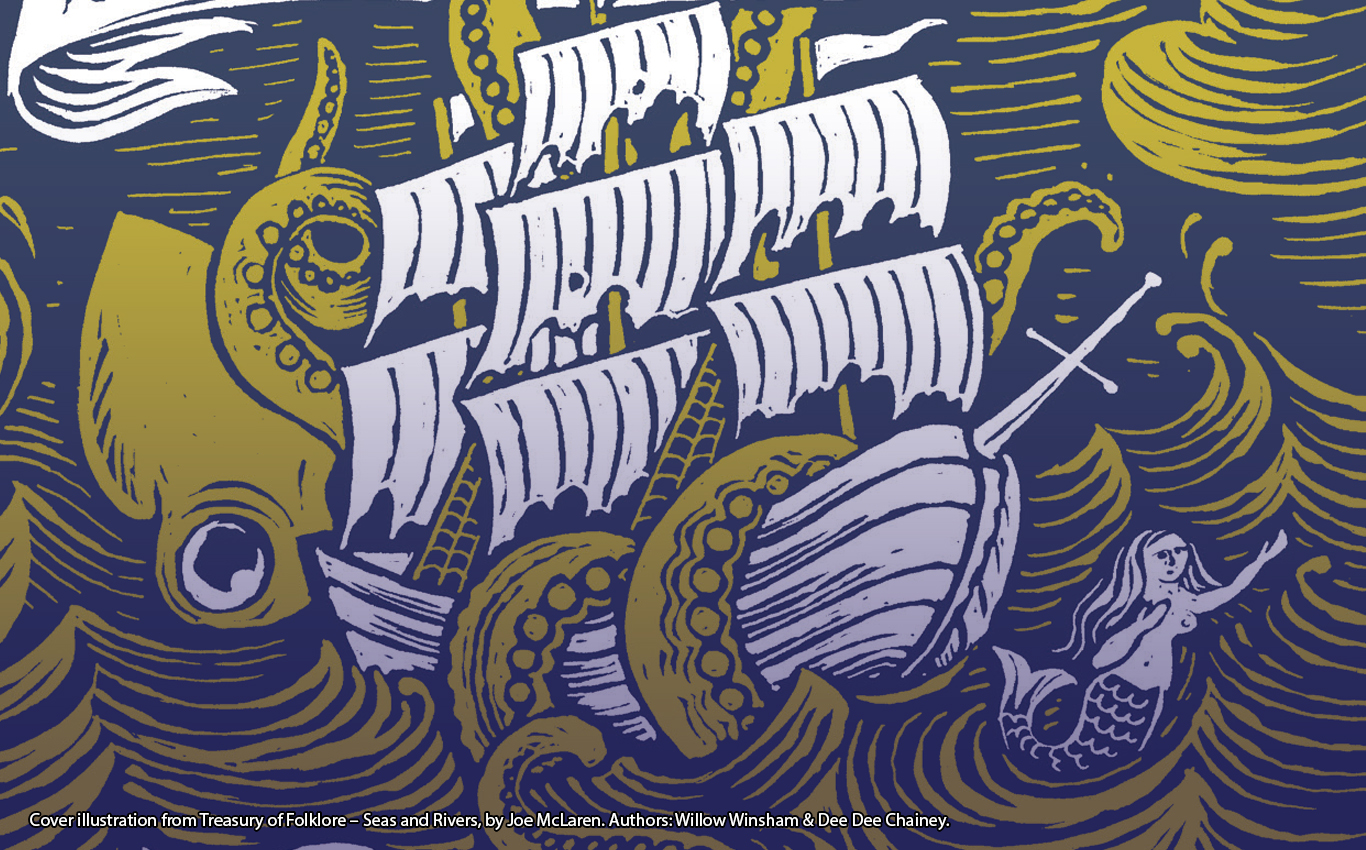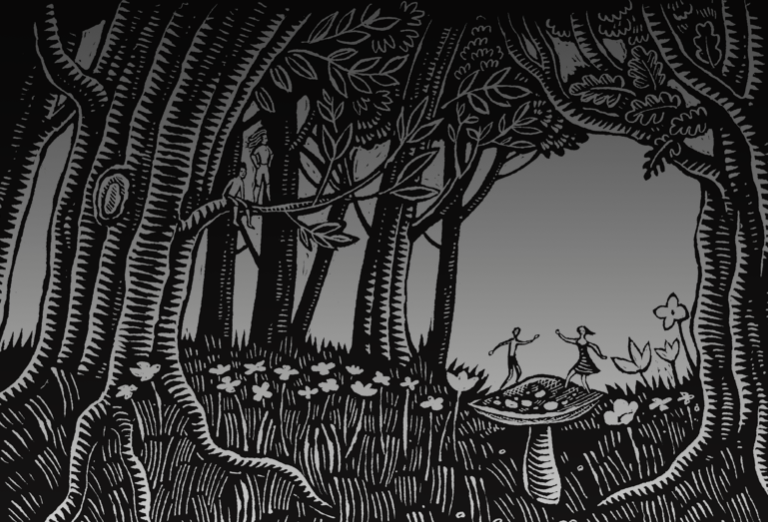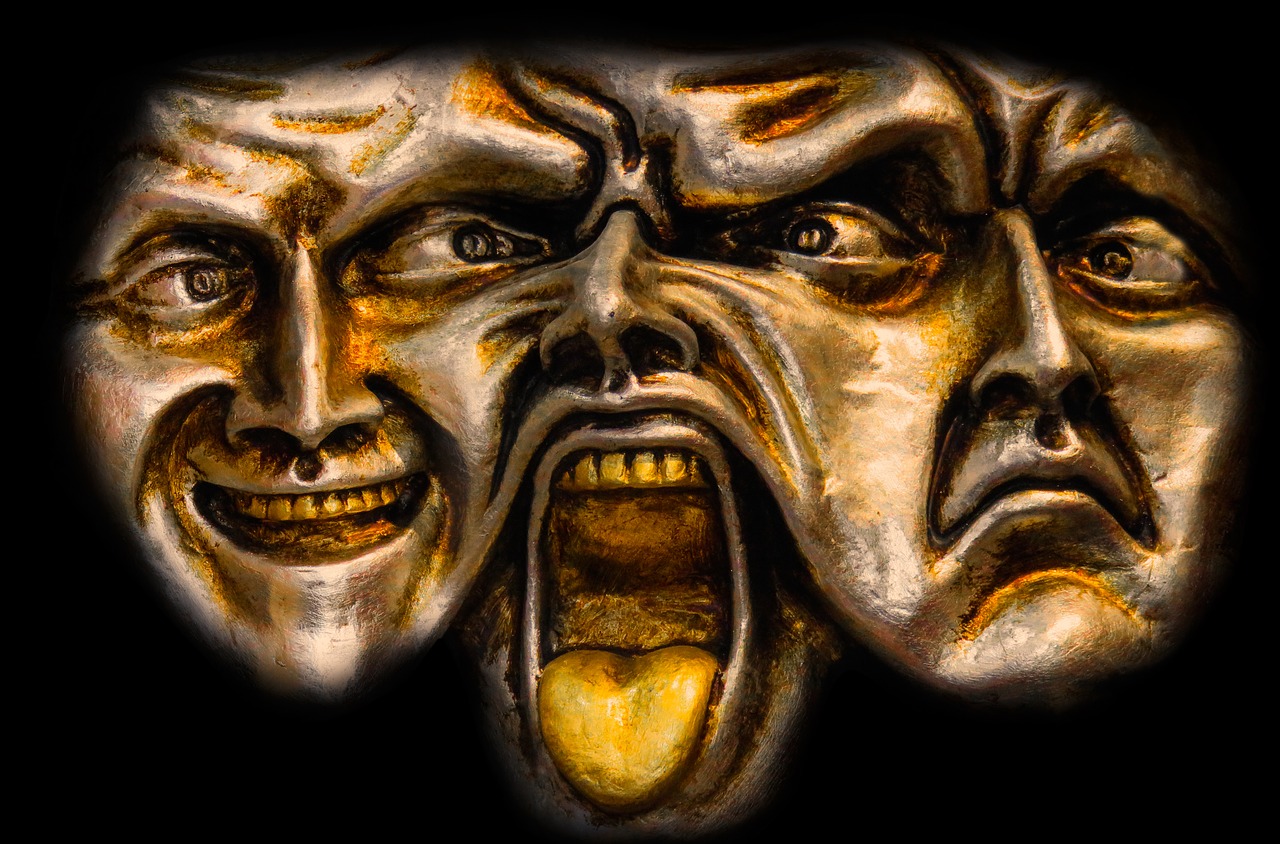We are so pleased to announce the release of #FolkloreThursday’s first book, Treasury of Folklore – Seas and Rivers: Sirens, Selkies and Ghost Ships, by @WillowWinsham and @DeeDeeChainey from @BatsfordBooks!
Treasury of Folklore – Seas and Rivers: Sirens, Selkies and Ghost Ships
By Dee Dee Chainey and Willow Winsham, illustrated by Joe McLaren
Enthralling tales of the sea, rivers and lakes from around the globe.
Folklore of the seas and rivers has a resonance in cultures all over the world. Watery hopes, fears and dreams are shared by all peoples where rivers flow and waves crash. This fascinating book covers English sailor superstitions and shape-shifting pink dolphins of the Amazon, Scylla and Charybdis, the many guises of Mami Wata, the tale of the Yoruba River spirit, the water horses of the Scottish lochs, the infamous mystery of the Bermuda Triangle, and much more.
Accompanied by stunning woodcut illustrations, popular authors Dee Dee Chainey and Willow Winsham explore the deep history and enduring significance of water folklore the world over, from mermaids, selkies and sirens to ghostly ships and the fountains of youth.
With this book, #FolkloreThursday aims to encourage a sense of belonging across all cultures by showing how much we all have in common.
The folklore attached to the seas and rivers of the world is plentiful, filled with wondrous creatures and beguiling tales. There are some places, however, that a cautious reader would do best to avoid: here are the top five watery locations featured in Treasury of Folklore – Seas and Rivers to steer well clear of.
Bäckahäst, the River Banks of Scandinavia
Water horses tend to have a bad reputation in folklore, and the Scandinavian bäckahäst is no exception. This majestic spirit is seen most commonly in foggy conditions, its luminous appearance tempting those who witness it to approach. The bäckahäst allowed the would-be rider to mount with ease, but all is not what it seems. With its victim firmly ensconced, the water horse dives down under the water: the rider, realising the peril too late, tries to dismount, but, unable to do so, they are drowned beneath the unforgiving waters of the river.
All is not lost: in several tales of the bäckahäst it is revealed that the creature hates the name of Jesus Christ, and if the would-be victim utters those words, he will be saved. The bäckahäst can also sometimes be tamed, but usually only for a short period of time.
Bear Lake Monster, Bear Lake, USA
Located on the border of Utah and Idaho, Bear Lake is said to be home to a fearsome creature. In 1868, renowned Mormon Joseph C Rich made fantastical claims about this creature, which he published in the Deserest Times. According to Rich’s tale, an old Native American story told of a serpent-like creature of enormous size that resided within the waters of the lake. This very creature had, Rich claimed, been witnessed in recent times by several upstanding citizens.
Rich’s article sparked the imaginations of the local people, and reports of sightings of the monster flooded in. According to reports, the creature was anything from twelve to twenty-seven metres long, with large eyes and bunch-like ears on the sides of its head. There was some confusion regarding the appearance of the creature’s head, with some saying it was like a crocodile’s, while others likened it more to that of a cow. The Bear Lake Monster was said to be a clumsy beast when on land, but in water it was another matter: speeds up to sixty miles per hour were recorded by witnesses.
Monster-fever gradually burnt out, and, twenty-six years later, Rich admitted that the tale was nothing but a hoax.

Scylla and Charybdis, Strait of Messina, Southern Italy
These dual threats to ships and men were well documented from Ancient times. According to the legends, Charybdis, located on the Sicillian side of the Strait, was a massive whirlpool. It sucked ships and the men aboard them down deep, before vomiting them back up and drowning all aboard in the process.
Scylla, on the other hand, was a monster more terrible than any known elsewhere. Living in a cave on the Calabrian side of the Strait, Scylla had a human face, dolphin tails, and nether regions surrounded by the heads of ravenous dogs. According to the stories, Scylla had once been a beautiful virgin. After she rejected Glaucus, a suitor who revealed to her how he had come to have a tail, the spurned would-be-lover went to the powerful sorceress Circe for aid in the form of a love potion. In a terrible twist, Circe in turn declared her love for Glaucus, only for him to reject her. Vowing revenge, Circe poisoned the water in the cave in which Scylla was sheltering, and she became the violent monster known today.
The Irish Joint Eater, Streams and Rivers, Ireland
Unwary travellers in the Emerald Isles should take care where they choose to take a nap. A nice stream-side location might seem like the perfect place to catch forty-winks, but it could well lead to your downfall. For it is here that the alp-luachara – also known as the Irish Joint Eater – lurks, waiting to find its prey.
This small, newt-like creature is a parasitical fairy with bad intentions: upon discovering a sleeping traveller, it slips down their throat, setting up home in the unsuspecting victim’s stomach. From that point on, any food that the man eats the creature takes for itself: as the joint eater grows stronger, the host slowly but surely wastes away, before dying of sheer starvation.
Acting quickly can, however, lead to a positive outcome. If the host eats something salty and waits beside the stream, the creature will emerge to quench its thirst. The scent of strong food can also tempt the creature from its new home.
The alp-luachara does have one noted use: licking it is said to be a cure for burns.

Bermuda Triangle, Atlantic Ocean © Joe McLaren
An area of ocean framed by Miami, Puerto Rico and Bermuda, strange disappearances of shipping and aircraft were first linked to the so-called Bermuda Triangle back in the 1950s. Despite this, tales of odd occurrences taking place in the area had been reported for some time, and continue to this day.
One of the most famous tales linked to the ill-famed triangle was that of Flight 19. When five TBM Avenger Torpedoes took off from Florida on 5 December, 1945, no one could suspect that the patrol would be anything other than routine. All changed however when, one hour and forty-five minutes into the two hour flight plan, the patrol leader communicated that they were off course and couldn’t see land. Not only that, the patrol was utterly disoriented, unable to get their bearings in any way whatsoever.
The control tower listened on helplessly as discussion between the pilots grew increasingly frantic, until the final, chilling communication: “Tower, we are not certain where we are…. we think we must be about two hundred and twenty miles north-east of base. It looks like we are—“
The doomed patrol was never found, and a vehicle and thirteen men that were sent to their aid, also vanished.
Explanations for disappearances in the area include compass variations, UFOs, violent weather conditions and technology from Atlantis.
All book images © Joe McLaren












